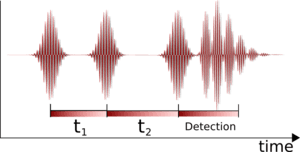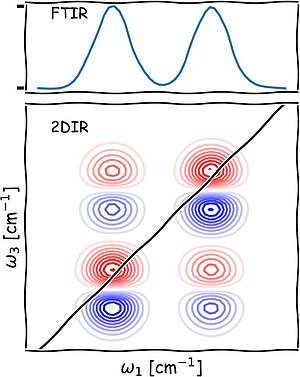Two-dimensional infrared spectroscopy
Two-dimensional infrared spectroscopy (2D IR) is a nonlinear infrared spectroscopy technique that has the ability to correlate vibrational modes in condensed-phase systems. This technique provides information beyond linear infrared spectra, by spreading the vibrational information along multiple axes, yielding a frequency correlation spectrum.[1][2] A frequency correlation spectrum can offer structural information such as vibrational mode coupling, anharmonicities, along with chemical dynamics such as energy transfer rates and molecular dynamics with femtosecond time resolution. 2DIR experiments have only become possible with the development of ultrafast lasers and the ability to generate femtosecond infrared pulses.

Systems studied
Among the many systems studied with infrared spectroscopy are water, metal carbonyls, short polypeptides, proteins, perovskite solar cells, and DNA oligomers.[3][4]
Experimental approaches
There are two main approaches to two-dimensional spectroscopy, the Fourier-transform method, in which the data is collected in the time-domain and then Fourier-transformed to obtain a frequency-frequency 2D correlation spectrum, and the frequency domain approach in which all the data is collected directly in the frequency domain.
Time domain
The time-domain approach consists of applying two pump pulses. The first pulse creates a coherence between the vibrational modes of the molecule and the second pulse creates a population, effectively storing information in the molecules. After a determined waiting time, ranging from a zero to a few hundred picoseconds, an interaction with a third pulse again creates a coherence, which, due to an oscillating dipole, radiates an infrared signal. The radiated signal is heterodyned with a reference pulse in order to retrieve frequency and phase information; the signal is usually collected in the frequency domain using a spectrometer yielding detection frequency . A two-dimensional Fourier-transform along then yields a (, ) correlation spectrum. In all these measurements phase stability among the pulses has to be preserved. Recently, pulse shaping approaches were developed to simplify overcoming this challenge.[5][6]
Frequency domain
Similarly, in the frequency-domain approach, a narrowband pump pulse is applied and, after a certain waiting time, then a broadband pulse probes the system. A 2DIR correlation spectrum is obtained by plotting the probe frequency spectrum at each pump frequency.
Spectral interpretation

After the waiting time in the experiment, it is possible to reach double excited states. This results in the appearance of an overtone peak. The anharmonicity of a vibration can be read from the spectra as the distance between the diagonal peak and the overtone peak. One obvious advantage of 2DIR spectra over normal linear absorption spectra is that they reveal the coupling between different states. This for example, allows for the determination of the angle between the involved transition dipoles.
The true power of 2DIR spectroscopy is that it allows following dynamical processes such as chemical exchange, vibrational population transfer, and molecular reorientation on the sub-picosecond time scale. It has for example been used successfully to study hydrogen bond forming and breaking and to determine the transition state geometry of a structural rearrangement in an iron carbonyl compound.[7] Spectral interpretation can be successfully assisted with developed theoretical methods.[8]
Currently, two freely available packages exists for modeling 2D IR spectra. These are the SPECTRON[9] developed by the Mukamel group (University of California, Irvine) and the NISE[10][11] program developed by the Jansen group (University of Groningen).
Solvent effect
The consideration of the solvent effect has been shown to be crucial [12][13] in order to effectively describe the vibrational coupling in solution, since the solvent modify both vibrational frequencies, transition probabilities [14] and couplings.[15][16] Computer simulations can reveal the spectral signatures arising from solvent degrees of freedom and their change upon water reorganization.[17][18]
See also
References
- P. Hamm; M. H. Lim; R. M. Hochstrasser (1998). "Structure of the amide I band of peptides measured by femtosecond nonlinear-infrared spectroscopy". J. Phys. Chem. B. 102 (31): 6123. doi:10.1021/jp9813286.
- Zanni, M.; Hochstrasser, RM (2001). "Two-dimensional infrared spectroscopy: a promising new method for the time resolution of structures". Current Opinion in Structural Biology. 11 (5): 516–22. doi:10.1016/S0959-440X(00)00243-8. PMID 11785750.
- S. Mukamel (2000). "Multidimensional Femtosecond Correlation Spectroscopies of Electronic and Vibrational Excitations". Annual Review of Physical Chemistry. 51: 691–729. Bibcode:2000ARPC...51..691M. doi:10.1146/annurev.physchem.51.1.691. PMID 11031297.
- M. H. Cho (2008). "Coherent Two-Dimensional Optical Spectroscopy". Chemical Reviews. 108 (4): 1331–1418. doi:10.1021/cr078377b. PMID 18363410.
- "Mid IR pulse shaper".
- Stone, K. W.; Gundogdu, K.; Turner, D. B.; Li, X.; Cundiff, S. T.; Nelson, K. A. (2009). "Two Quantum 2D FT Spectroscopy". Science. 324 (5931): 1169–1173. doi:10.1126/science.1170274. PMID 19478176.
- Cahoon, J. F.; Sawyer, K. R.; Schlegl, J. P.; Harris, C. B. (2008). "Determining transition-state geometries in liquids using 2D-IR". Science (Submitted manuscript). 319 (5871): 1820–3. Bibcode:2008Sci...319.1820C. doi:10.1126/science.1154041. PMID 18369145.
- Liang, C.; Jansen, T. L. C. (2012). "An efficient N3-scaling propagation scheme for simulating two-dimensional infrared and visible spectra". Journal of Chemical Theory and Computation. 8 (5): 1706–1713. doi:10.1021/ct300045c. PMID 26593664.
- "The Mukamel Group: Software". mukamel.ps.uci.edu.
- "Computational Spectroscopy". fwn-nb4-7-208.chem.rug.nl.
- "Github NISE release". github.com.
- DeChamp, M. F.; DeFlores, L.; McCraken, J. M.; Tokmakoff, A.; Kwac, K.; Cho, M.H. (2005). "Amide I vibrational dynamics of N-methylacetamide in polar solvents: The role of electrostatic interactions". The Journal of Physical Chemistry B. 109 (21): 11016–26. doi:10.1021/jp050257p. PMID 16852342.
- Lee, Chewook; Cho, Minhaeng (2007). "Vibrational dynamics of DNA: IV. Vibrational spectroscopic characteristics of A-, B-, and Z-form DNA's". J. Chem. Phys. 126 (14): 145102. Bibcode:2007JChPh.126n5102L. doi:10.1063/1.2715602. PMID 17444751.
- Schmidt, J. R.; Corcelli, S. A.; Skinner, J. L. (2005). "Pronounced non-condon effects in the ultrafast infrared spectroscopy of water". J. Chem. Phys. 123 (4): 044513. Bibcode:2005JChPh.123d4513S. doi:10.1063/1.1961472. PMID 16095375.
- Gorbunov, R. D.; Kosov, D. S.; Stock, G. (2005). "Ab initio-based exciton model of amide I vibrations in peptides: Definition, conformational dependence, and transferability". J. Chem. Phys. 122 (22): 224904. Bibcode:2005JChPh.122v4904G. doi:10.1063/1.1898215. PMID 15974713.
- Biancardi, A.; Cammi, R.; Mennucci, B.; Tomasi, J. (2011). "Modelling vibrational coupling in DNA oligomers: a computational strategy combining QM and continuum solvation models". Theoretical Chemistry Accounts: Theory, Computation, and Modeling (Theoretica Chimica Acta). 131 (3): 1157. doi:10.1007/s00214-012-1157-3.
- Baron, Riccardo; Setny, Piotr; Paesani, Francesco (2012). "Water structure, dynamics, and spectral signatures: changes upon model cavity-ligand recognition". Journal of Physical Chemistry B. 116 (46): 13774–80. doi:10.1021/jp309373q. PMID 23102165.
- Jansen, T. L. C.; Knoester, J. (2006). "A Transferable Electrostatic Map for Solvation Effects on Amide I Vibrations and its Application to Linear and Two-Dimensional Spectroscopy" (PDF). Journal of Chemical Physics. 124 (4): 044502. Bibcode:2006JChPh.124d4502L. doi:10.1063/1.2148409. PMID 16460180.